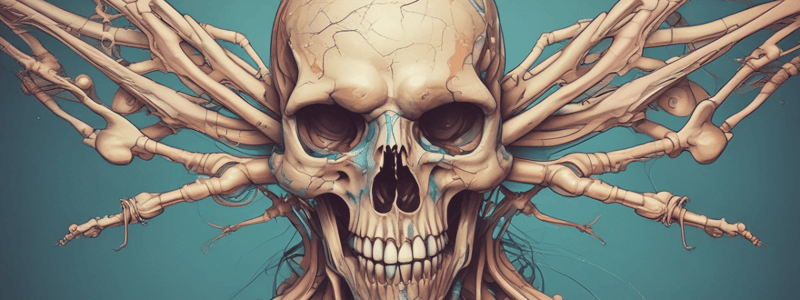Podcast
Questions and Answers
What are the characteristic bone deformities observed in individuals with X-linked hypophosphatemia?
What are the characteristic bone deformities observed in individuals with X-linked hypophosphatemia?
- Bowed legs and short stature (correct)
- Genu valgum and genu recurvatum
- Club foot and scoliosis
- Kyphosis and lordosis
What is the primary defect that leads to hypophosphatemia in X-linked hypophosphatemia?
What is the primary defect that leads to hypophosphatemia in X-linked hypophosphatemia?
- Excessive phosphate excretion in the urine
- Impaired phosphate absorption in the gut
- Defect in phosphate reabsorption in the proximal tubules of the kidneys (correct)
- Increased phosphate utilization in bone growth
Why may vitamin D supplementation be ineffective in individuals with X-linked hypophosphatemia?
Why may vitamin D supplementation be ineffective in individuals with X-linked hypophosphatemia?
- Vitamin D is not converted to its active form
- Vitamin D is not absorbed properly in the gut
- The body is resistant to vitamin D therapy (correct)
- Vitamin D is broken down too quickly
What is the pattern of inheritance for X-linked hypophosphatemia?
What is the pattern of inheritance for X-linked hypophosphatemia?
What is the function of the protein encoded by the PHEX gene?
What is the function of the protein encoded by the PHEX gene?
Who are more likely to be affected by X-linked hypophosphatemia?
Who are more likely to be affected by X-linked hypophosphatemia?
How does impaired bone development in X-linked hypophosphatemia affect the overall structure and function of bones?
How does impaired bone development in X-linked hypophosphatemia affect the overall structure and function of bones?
What is the underlying mechanism behind the resistance to vitamin D therapy in X-linked hypophosphatemia?
What is the underlying mechanism behind the resistance to vitamin D therapy in X-linked hypophosphatemia?
How does the X-linked dominant inheritance pattern of X-linked hypophosphatemia affect the expression of the disease in males and females?
How does the X-linked dominant inheritance pattern of X-linked hypophosphatemia affect the expression of the disease in males and females?
What role does FGF23 play in the development of hypophosphatemia in X-linked hypophosphatemia?
What role does FGF23 play in the development of hypophosphatemia in X-linked hypophosphatemia?
How does the impairment of osteoblast and osteoclast function contribute to the development of bone abnormalities in X-linked hypophosphatemia?
How does the impairment of osteoblast and osteoclast function contribute to the development of bone abnormalities in X-linked hypophosphatemia?
What is the relationship between phosphate homeostasis and bone development in X-linked hypophosphatemia?
What is the relationship between phosphate homeostasis and bone development in X-linked hypophosphatemia?
What is the primary consequence of phosphate wasting in the kidneys for individuals with X-linked hypophosphatemia?
What is the primary consequence of phosphate wasting in the kidneys for individuals with X-linked hypophosphatemia?
How does the increased production of fibroblast growth factor 23 (FGF23) contribute to the development of hypophosphatemia in X-linked hypophosphatemia?
How does the increased production of fibroblast growth factor 23 (FGF23) contribute to the development of hypophosphatemia in X-linked hypophosphatemia?
What is the significance of the X-linked nature of X-linked hypophosphatemia in terms of disease expression in males and females?
What is the significance of the X-linked nature of X-linked hypophosphatemia in terms of disease expression in males and females?
What is the primary goal of phosphate supplements and calcitriol in the treatment of X-linked hypophosphatemia?
What is the primary goal of phosphate supplements and calcitriol in the treatment of X-linked hypophosphatemia?
What is the potential consequence of untreated X-linked hypophosphatemia in terms of bone health?
What is the potential consequence of untreated X-linked hypophosphatemia in terms of bone health?
How does the measurement of serum phosphate levels contribute to the diagnosis of X-linked hypophosphatemia?
How does the measurement of serum phosphate levels contribute to the diagnosis of X-linked hypophosphatemia?
What is the role of orthopedic management in the treatment of X-linked hypophosphatemia?
What is the role of orthopedic management in the treatment of X-linked hypophosphatemia?
What is the potential long-term consequence of X-linked hypophosphatemia in terms of kidney function?
What is the potential long-term consequence of X-linked hypophosphatemia in terms of kidney function?
Flashcards are hidden until you start studying
Study Notes
X-Linked Hypophosphatemia
Bone Development
- X-linked hypophosphatemia is a disorder that affects bone development and mineralization
- Characterized by impaired bone growth and deformities, such as bowed legs and short stature
- Abnormal bone mineralization leads to rickets (in children) and osteomalacia (in adults)
Phosphate Homeostasis
- Defect in phosphate reabsorption in the proximal tubules of the kidneys
- Increased phosphate excretion in the urine, leading to hypophosphatemia
- Impaired phosphate homeostasis disrupts bone mineralization and growth
Vitamin D Resistance
- X-linked hypophosphatemia is characterized by resistance to vitamin D therapy
- Patients may not respond to vitamin D supplementation, despite adequate doses
- Vitamin D resistance contributes to impaired bone mineralization and growth
Genetic Inheritance
- X-linked hypophosphatemia is an X-linked dominant disorder
- Caused by mutations in the PHEX gene, which codes for a phosphate-regulating neutral endopeptidase
- Females are more commonly affected, but males can also be affected
- Inheritance pattern: mothers can pass the mutated gene to their sons (who are often more severely affected) and daughters (who may be carriers)
X-Linked Hypophosphatemia
Bone Abnormalities
- Affects bone development, leading to impaired bone growth and deformities
- Characterized by bowed legs and short stature
- Abnormal bone mineralization causes rickets in children and osteomalacia in adults
Phosphate Homeostasis Disruption
- Defect in phosphate reabsorption in the kidneys' proximal tubules
- Increased phosphate excretion in urine, resulting in hypophosphatemia
- Impaired phosphate homeostasis disrupts bone mineralization and growth
Vitamin D Therapy Resistance
- Characterized by resistance to vitamin D therapy
- Patients may not respond to vitamin D supplementation, despite adequate doses
- Vitamin D resistance contributes to impaired bone mineralization and growth
Genetic Characteristics
- X-linked dominant disorder
- Caused by mutations in the PHEX gene
- PHEX gene codes for a phosphate-regulating neutral endopeptidase
- Females are more commonly affected, but males can also be affected
- Mothers can pass the mutated gene to their sons (who are often more severely affected) and daughters (who may be carriers)
X-Linked Hypophosphatemia
Bone Development
- Rickets and osteomalacia are characteristic of the disorder, resulting in impaired bone mineralization and softening of bones
- Bowed legs, knock knees, and short stature are common physical manifestations due to impaired bone development
- Abnormal bone matrix mineralization and bone remodeling occur, leading to functional impairments in osteoblasts and osteoclasts
Vitamin D Resistance
- Vitamin D therapy is ineffective in treating the disorder due to resistance
- Low levels of active vitamin D (1,25-dihydroxyvitamin D) are present despite normal or elevated levels of inactive vitamin D (25-hydroxyvitamin D)
- Impaired conversion of 25-hydroxyvitamin D to 1,25-dihydroxyvitamin D is a key feature of the disorder
Genetic Inheritance
- X-linked dominant inheritance pattern characterizes the disorder
- Mutations in the PHEX gene cause the disorder
- Heterozygous females are typically affected, while hemizygous males are more severely affected
Phosphate Homeostasis
- Hypophosphatemia (low blood phosphate levels) is a hallmark of the disorder
- Impaired phosphate reabsorption in the kidneys leads to excessive phosphate excretion in the urine
- Elevated levels of FGF23, which inhibits phosphate reabsorption in the kidneys, contribute to the disorder
Definition and Prevalence
- X-linked hypophosphatemia (XLH) is a rare genetic disorder characterized by phosphate wasting in the kidneys, leading to hypophosphatemia (low phosphate levels in the blood).
- It is the most common form of inherited hypophosphatemic rickets.
- Prevalence: approximately 1 in 20,000 births.
Genetics
- XLH is caused by mutations in the PHEX (phosphate-regulating gene with homologies to endopeptidases on the X chromosome) gene.
- The PHEX gene is located on the X chromosome, which is why the disorder is X-linked.
- Mutations in the PHEX gene lead to increased production of fibroblast growth factor 23 (FGF23), which inhibits phosphate reabsorption in the kidneys.
Clinical Features
- Hypophosphatemia (low phosphate levels in the blood)
- Rickets (softening of bones in children)
- Osteomalacia (softening of bones in adults)
- Short stature
- Bone deformities (e.g., bowed legs)
- Dental problems (e.g., abscesses, extractions)
- Weak muscles
- Fatigue
Diagnosis
- Measurement of serum phosphate levels
- Radiographic evaluation of bone deformities
- Genetic testing for PHEX gene mutations
- FGF23 levels may be elevated
Treatment
- Phosphate supplements
- Calcitriol (active form of vitamin D)
- Orthopedic management of bone deformities
- Dental care to prevent complications
- Growth hormone therapy in some cases
Complications
- Chronic kidney disease
- Nephrocalcinosis (calcium deposits in the kidneys)
- Osteoarthritis
- Dental abscesses and extractions
- Increased risk of fractures
Inheritance
- X-linked recessive pattern of inheritance
- Females are carriers and may have mild symptoms
- Males are more severely affected due to the X-linked nature of the disorder
Studying That Suits You
Use AI to generate personalized quizzes and flashcards to suit your learning preferences.




